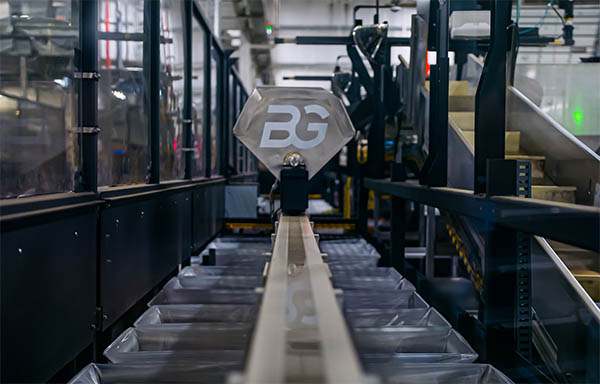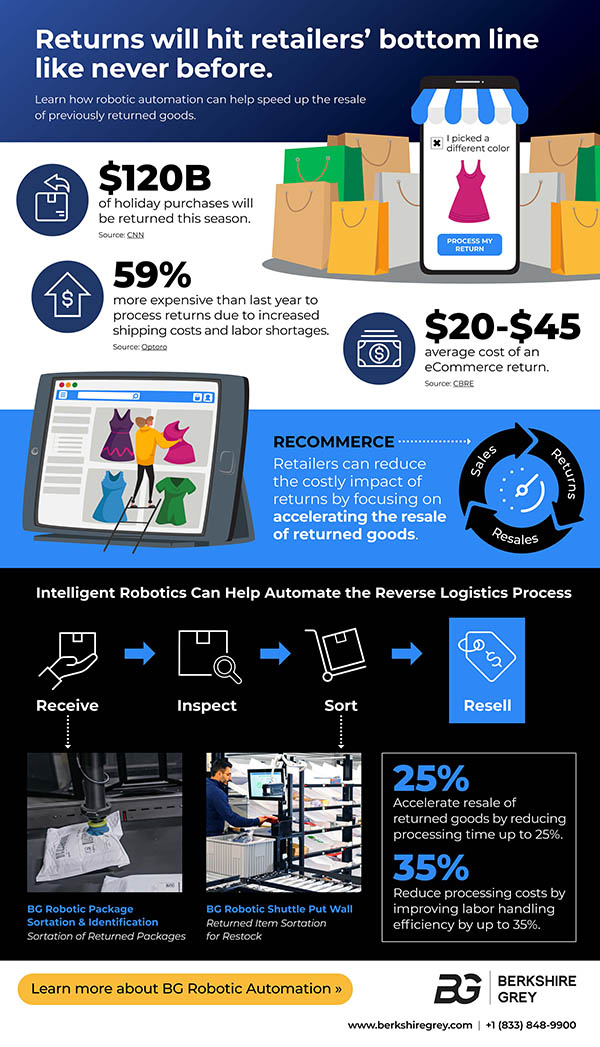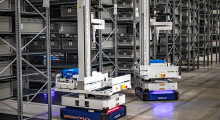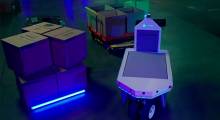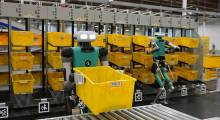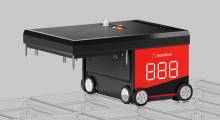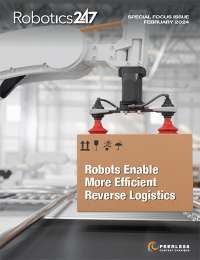While the holiday shopping rush may be over, retailers are still dealing with the increasing flow of returns. Berkshire Grey Inc. today introduced its Reverse Logistics system to help retailers accelerate the resale of returned goods and improve labor utilization in the returns process.
“Returns processing has a significant adverse impact on the real profitability of e-commerce,” said Steve Johnson, president and chief operating officer of Berkshire Grey. “As online shopping continues to grow, returns operations, while more critical than ever post-holiday season, are struggling to keep up.”
“By applying robotic automation to optimize reverse-logistics processing, e-commerce retailers and 3PLs [third-party logistics providers] have an opportunity to change the equation for e-commerce returns and turn a negative into a positive,” he added.
Consumer convenience poses retailer challenge
Consumers expect free, no-hassle returns for their online purchases, noted Bedford, Mass.-based Berkshire Grey. In 2020, U.S. consumers returned 10.6% of total retail sales—or $428 billion in products—and about 5.9% were fraudulent, equating to $25.3 billion in losses, according to the National Retail Federation.
By the end of January, consumers will return will return an estimated $120 billion of goods, creating a significant inventory and cost challenge.
These “easy” returns have been a driver for e-commerce growth, particularly in apparel, footwear, electronics, and luxury items, said Berkshire Grey. However, the average cost of such a return, regardless of item, ranges from $20.75 to $45.25 when factoring in the costs of transportation, processing, and markdowns or liquidation to resell, the company said.
“We were alerted to this when customers talked about problems for e-commerce,” said Kishore Boyalakuntla, vice president of product at Berkshire Grey. “Twenty to 30% of all things people order are returned in late December or early January.”
“From a retailer standpoint, they spend a lot on advertising, and their profit margins are in the 10% to 25% range. But if 30% is returned, there's no margin at all,” he told Robotics 24/7. “Everything needs to be inspected and sorted before it can go back into the sales cycle or back to a store shelf.”
Returns differ by vertical segment, region
“Up to 40% to 50% of apparel is returned, and it's also pretty high in automotive,” said Boyalakuntla. “With electronics or automotive, retailers will attempt to put goods back on the shelf, but in apparel, it's often not worth it because they don't know if someone wore it, labels and packaging are missing, and there may be damage.”
“There are geographic differences in returns as well,” he added. “In Germany, 50% of goods may be returned. The U.K. is also high, and the U.S. is slightly lower.”
“The stategies retailers employ are also different,” Boyalakuntla said. “In Europe, distribution centers are close to population centers, so it's easier to do returns, but in the U.S., they're farther away, so it's more profitable to put items back on the shelf of a retail outlet rather than go back to the DC. Also in Europe, we're working with customers that have built solutions centers focused only on reverse logistics.”
“Another aspect is that the cost of returns has gone up, so some retailers have said don't even bother to return items, or they even go straight to a landfill,” he said. “Some luxury retailers don't want secondhand things like purses sold at half price, so they shred them. We realized at Berkshire Grey that we could make a difference for profitability and sustainability.”
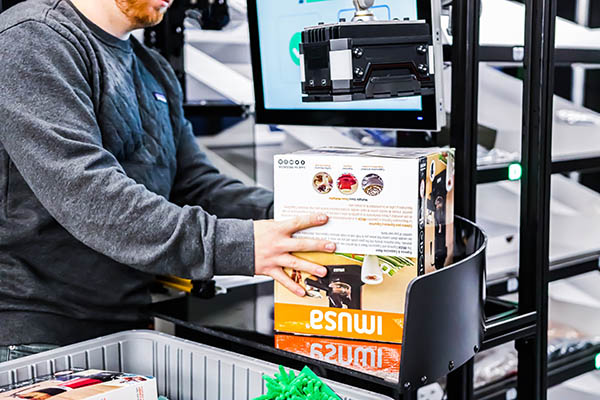
Berkshire Grey offers Reverse Logistics solution
“A great reverse-logistics supply chain can be a valuable profit contributor to a retail company through its ability to optimize the resale of returned merchandise at full price,” said a Gartner report.
Reverse logistics is different from outbound e-commerce in that order fulfillment involves putting orders in mixed bins, while returns need to be grouped by brand, noted Boyalakuntla. “Standard e-commerce products won't work for returns, and the integration points are different,” he said.
“Because you're putting hundreds of a single thing, such as lipstick, in one space rather than a few things in a shared space, the workflow and bin and shelf sizes are different,” Boyalakuntla said. “This requires changes to the hardware configuration and software logic.”
Berkshire Grey said it combines robotics and artificial intelligence to automate picking, packing, and sortation operations. The company's Reverse Logistics offering includes its Robotic Product Sortation with Identification (RPSi) and Robotic Shuttle Put Wall (RSPW) systems, both of which are specifically configured to efficiently process returns.
The company said RPSi allows 3PLs and other central returns-processing centers to pre-sort incoming packages by brand and merchandise category prior to opening and inspecting them. RSPW rapidly sorts returned products for faster putaway. Both systems can improve labor utilization and make returns faster and cheaper, ultimately improving profitability, said Berkshire Grey.
“We don't sell products; we implement systems,” Boyalakuntla added. “We need less than 2,000 sq. ft. to implement a putwall or robotic sortation. In the context of a 500,000-sq.-ft. warehouse, that's very small. Our systems could even work in a store and are customized for each customer's KPIs [key performance indicators].”
Customer feedback feeds robotic response
Berkshire Grey claimed that Reverse Logistics can reduce markdowns by speeding up returns processing. As a result, goods can be moved back into inventory or to refurbishment up to 25% faster than manual processing.
In addition, automation can free workers to focus on the higher value-added inspections process. Reverse Logistics can improve labor handling efficiency by up to 35% and reduce processing costs, said the company.
“Over the past two years, almost every customer we've talked to has said returns are a very high priority to address,” Boyalakuntla said. “We're learning from our customers and are trying to address the supply chain and environmental challenges in a meaningful way.”
About the Author
Follow Robotics 24/7 on Linkedin
Article topics
Email Sign Up

